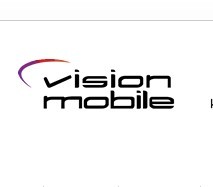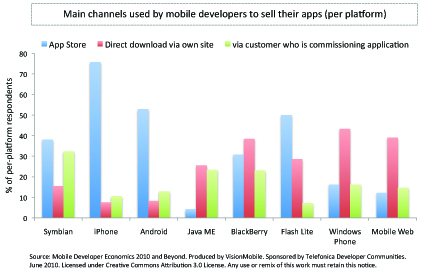Vision Mobile报告:2010手机应用开发者经济评估和其他
Vision Mobile发布了最近的检验报告:2010手机应用开发者经济评估和其他。该报告调查范围涉及全球400家以上的手机应用开发者,调查平台包括iOS (苹果iPhone)、Android(google)、Symbian(诺基亚), BlackBerry(黑莓手机), Java ME(Java平台), Windows Phone(微软), Flash/Flash Lite(adobe公司)和mobile web 。
该调查主要是针对手机应用开发者的市场运作而进行的。涉及问题包括如下:
* Platform features: which aspects of their platform do developers perceive as being most important?
* Planning techniques: what are the most popular methods developers use to plan their applications in terms of features and target segment?
* App stores: which app stores are used, based on the developers’ platform of choice?
* How much cross-pollination is taking place across Android and iOS developers today?
* Developer challenges: what are the top-4 challenges developers face when taking their applications to market?
* Revenue models: what are the most popular revenue models and in which cases are ad-funded models used?
从列表中,我们可以看到,iphone和android平台上直接从应用程序商店下载,分别占到了70%和60%以上,这两大手机程序平台的平台化相比其他的平台更加地明显。
Market strategy firm Vision Mobile released a very interesting survey report this week, called “Mobile Developer Economics 2010 and Beyond”. The report goes into many aspects of mobile app development based on surveying 400+ worldwide developers, segmented into the eight major mobile platforms: iOS (iPhone), Android, Symbian, BlackBerry, Java ME, Windows Phone, Flash/Flash Lite and mobile web (WAP/XHTML/CSS/JavaScript). The full report is available free of charge here.
We’d like to take some aspects focussed on mobile app distribution and app stores from the report:
Taking applications to marketThe research goes into the question how developers nowadays take their applications to market. A lot has changed in a few years. While operator deals were a main method of distribution of mobile apps, operator portals and on-device preloading through OEM or operator deals is the primary channel to market for fewer than five percent of the surveyed developers. The preferred go-to-market
channel for applications varies significantly by platform. The vast majority of iPhone respondents designate an app store as their primary channel for selling apps, followed by around 50 percent of the Android and Flash developers.
Time to shelf and payment
According to the report, app stores have revolutionised time to market for applications. To research exactly how radical the time to market for applications has changed since the introduction of app stores, the survey focused on two parameters:
* Time to shelf, i.e. how long it takes from submitting an application to that application being available for purchase
* Time to payment, i.e. the length of time between an application being sold and the proceeds reaching the developer’s bank account
The report’s findings show that app stores have reduced the average time-to-shelf by two thirds: from 68 days across traditional channels, to 22 days via an app store:
For developers choosing an app store to retail their apps, almost 60 percent get paid within a month from the sale of the application. In contrast, when using traditional channels, the time-to-payment increases substantially. On average it takes 55 days to get paid via an operator channel, 69 days when preloading an app via an operator and a whopping 168 days (5.5 months) when pre-loading an app via a handset manufacturer. All in all, app stores reduce the time-to-payment by more than half; from 82 days on average in the case of traditional channels, to 36 days on average with app stores.










































 闽公网安备35020302001549号
闽公网安备35020302001549号